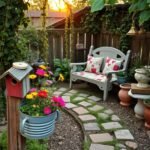Imagine transforming any room into a lush, living landscape that thrives with minimal effort. These compact plant arrangements, often called dish gardens, let you design a personalized ecosystem in shallow containers. Perfect for small spaces, they combine multiple varieties to create stunning visual harmony while purifying your indoor air.
Unlike temporary floral displays, these living collections grow and evolve over time. Beginners love their adaptability – they’re far more forgiving than single-plant setups. Whether you prefer desert succulents or tropical foliage, our dish gardening basics make it simple to start.
Seasonal updates keep your creation fresh year-round. Swap blooming accents for holiday themes or add decorative stones for texture. Curious about potential challenges? Even thriving setups occasionally need adjustments, as detailed in this troubleshooting resource for similar ecosystems.
Your home gains more than beauty – these miniature worlds become natural stress relievers and conversation starters. With smart plant pairings and proper setup, you’ll enjoy a dynamic display that outlasts cut flowers while developing your green thumb skills.
Understanding the Dish Garden Concept

Creating a miniature ecosystem at home starts with understanding its core components. These living arrangements combine aesthetics with practicality, blending plants into a cohesive display that adapts to your space.
What Exactly Is a Dish Garden?
Think of it as a tiny, self-contained world where plants share resources. Unlike traditional pots, these setups use open, low-profile vessels—like wide ceramic trays or repurposed baskets—to create visual depth. The limited soil depth encourages roots to spread horizontally, mimicking natural groundcover patterns.
Choosing the Perfect Container and Providing Drainage
Your vessel’s design impacts both style and plant health. Terra cotta dishes or decorative ceramics work well, but even vintage teacups can become charming homes for small succulents. For choosing the right container size, prioritize width over depth to accommodate multiple plants.
Drainage matters most in shallow setups. If your bowl lacks holes, line it with pebbles or charcoal to prevent soggy roots. Some enthusiasts use plastic inserts with pre-drilled openings for easy maintenance. This approach lets you swap liners seasonally without disturbing the arrangement.
Ceramic options shine for durability and style variety. Their weight stabilizes top-heavy plants, while glazed finishes complement modern interiors. Just remember: check moisture levels more often than with deeper pots, as evaporation happens faster in compact spaces.
Dish Garden Care Tips: Watering, Lighting, and Soil Essentials

Maintaining a thriving miniature ecosystem requires precision in three key areas. Let’s explore how to balance moisture, light exposure, and growing mediums for lasting results.
Watering Techniques and Drainage Solutions
Target plant roots directly using a narrow-spout container. This method prevents oversaturation – especially crucial in shallow setups. Seasonal adjustments matter: increase frequency during active growth periods, then reduce in dormancy.
Check moisture by pressing a finger into the topsoil. If it feels dry an inch down, it’s time for hydration. For smart watering techniques, try squeeze bottles for hard-to-reach specimens.
| Environment | Water Frequency | Tool Recommendation |
|---|---|---|
| Indoor (Winter) | 3-4 weeks | Moisture meter |
| Outdoor (Summer) | 10-14 days | Long-necked can |
Optimal Lighting Conditions
Match illumination to your plants’ origins. Desert varieties crave 6+ hours of direct sun, while tropical types prefer bright, indirect exposure. Rotate arrangements weekly for even growth.
Indoor setups thrive near east-facing windows. Use sheer curtains to filter intense afternoon rays. For dark spaces, LED grow lights work wonders – position them 12-18 inches above foliage.
Peat-based mixes strike the perfect balance for most species. They retain moisture without drowning roots, creating a stable foundation for diverse plant communities.
Plant Selection and Creative Arrangement

Crafting a stunning miniature landscape begins with smart plant pairings. Start with young specimens in 3-4″ containers – their compact size allows flexible placement while leaving room for growth.
Matching Plant Requirements for Cohesive Growth
Group sun-loving varieties like jade plants with cacti, or shade-preferring ferns with philodendrons. This ensures all specimens flourish under identical care routines. Pro tip: Use trailing varieties like pothos to soften container edges naturally.
| Plant Type | Light Needs | Water Frequency |
|---|---|---|
| Succulents/Cacti | Full sun | Every 3 weeks |
| Tropicals | Bright indirect | Weekly |
| Flowering Varieties | Medium light | When soil dries |
Seasonal Design Updates
Swap blooming stars seasonally – poinsettias add holiday cheer, while primroses burst with spring color. Tuck decorative moss between plants for year-round texture. These living gifts become cherished keepsakes for weddings or anniversaries.
Soil Nutrition Strategies
Refresh potting mix each spring with a 1/4″ compost layer. This slow-release nourishment prevents salt buildup common in shallow containers. For flowering varieties, supplement with diluted liquid fertilizer during bloom cycles.
Wrapping Up Your Dish Garden Journey
Your journey into miniature gardening offers lasting rewards with minimal effort. These living arrangements thrive for 1-2 years in their containers, needing only basic attention to light exposure and drainage needs. Position specimens slightly above the soil line to account for natural settling over time.
Routine care becomes effortless once established. Remove yellowing leaves promptly and check for pests during seasonal changes. If using decorative moss or tight groupings, reduce watering frequency since these slow soil drying.
Refresh your display each spring by rotating plants or adding colorful accents. Multiple arrangements brighten any room – try a cheerful ceramic piece in your dining area or a textured basket display for holidays. Share your creations as unique gifts that keep growing long after special occasions.
Through this process, you’ll discover how small green spaces boost your home’s ambiance while sharpening your gardening instincts. Every adjustment teaches valuable lessons about plant needs and creative design possibilities. Now go cultivate something extraordinary – your thriving miniature world awaits!






